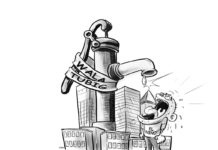
WHEN I was an IT (information technology) consultant at the Makati City Hall, we implemented a Geographic Information System (GIS) primarily for the purpose of computerizing the city’s Real Property Tax Assessment System (RPTAS).
It was there that I learned that flat analog maps are really not reliable as legal basis for defining property lines, because these are almost always inaccurate.
I also learned that the best approach to solve the problem is to conduct a new land survey that would define property lines based on coordinates, and not based on the old cement markers.
Because of the RPTAS that we implemented, there was an increase of real property tax collections, meaning that the investment of the city government was worth every penny of it, and the project became a major source of income for the city.
At that time, however, internet based online services were not yet available, so what we implemented was really an offline system that was only running in a Local Area Network (LAN). Fast forward to today, I am now an IT consultant for the Marinduque provincial government, and I now have a new opportunity to implement a province-wide RPTAS, covering six LGUs.
But now that internet access is available, we are going to make sure that the service will be online. That way, any owner of any piece of property within the province could pay for their real property taxes any time and from anywhere, even if they are not in the province.
FOOD AND WATER SECURITY COMBINED
Without meaning to, Fr. Nards Guiritan of the Diocese of Butuan might have invented a two-in-one strategy that combines the assurance of food and water security for the people of his diocese now, and for generations to come.
This might sound an old idea, but Fr. Nards is now aggressively pursuing this approach with new vigor.
Actually, Fr. Nards is not new to this kind of work, for so many years now, he has successfully combined food and job security projects with a similar two-in-one combination.
Not owning any land of his own, he “borrows” idle lands from willing landowners and plants crops on them thus giving jobs to his farmer beneficiaries and giving them food eat as well.
Now alarmed that fresh water supply is running out in the communities within his diocese, he sought the blessings of his bishop to plant and grow fruit trees in the denuded mountains around him.
Since I grew up in one of those communities, I know for a fact that we have lost the water supply simply because we have lost the forest cover in our mountains. Targeting both the indigenous people and the landless farmers in the diocese, he is again “borrowing” land not only from the government, but also from the willing landowners.
I suggested to him to try the “lease-purchase” or rent-to-own approach, and he liked the idea. Now I am asking volunteer lawyers to create the legal framework for him. For sure, we can do this in other dioceses also./PN



